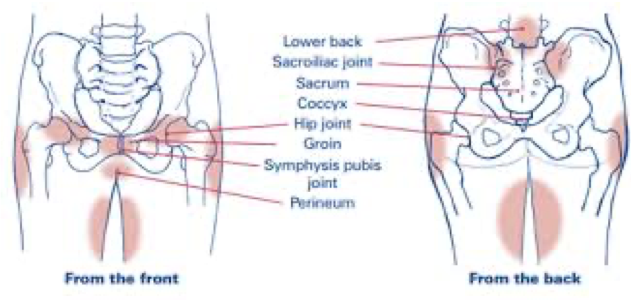Pregnancy-related Pelvic Girdle Pain (PGP).
Pregnancy-related PGP can occur in up to 20% of women! Because of this huge number we thought we would write a blog to tell you a bit more about it and how we can help!
What is pregnancy-related PGP?
- PGP is pain located in any of the areas shown on the following pic. It varies between individuals, some women may feel pain only in the front of their pelvis/pubic symphysis, while others may feel pain located only in their lower back/SIJ area. In some women the pain feels sharp and burning, while others feel a dull ache.
- Pregnancy-related PGP usually begins around the 18th week of pregnancy and peaks by the 24-36 week mark. However, in some cases, women still experience the pain post partum.
- Common symptoms
- Waddling/difficulty walking
- Pain when standing on 1 leg – e.g. climbing stairs/dressing
- Pain getting in/out of car or bath
- Difficulty lying in some positions
- Pain with prolonged standing/walking or sitting
What causes pregnancy-related PGP?
- The exact cause is still unknown, however it is thought that hormones play a role. During pregnancy, the body produces hormones which loosen off some ligaments to allow your body to prepare for the carrying the baby and the birth. The laxity of these ligaments causes the pelvis to be slightly less stable and change the way our joints are loaded, in some people this can result in pain.
How can a physio help?
- First and foremost it is important to be correctly diagnosed. There are other causes of pain in those areas so assessment by a health professional is important.
- Physiotherapists will work with you to aim to increase your strength and stability as well as controlling your pain and function. Physio sessions will include advice and education on how you can prevent or reduce your pain, as well as exercise prescription to build up your strength.
If you are unsure if this is you or not, give us a call or pop in to see a physio today.

